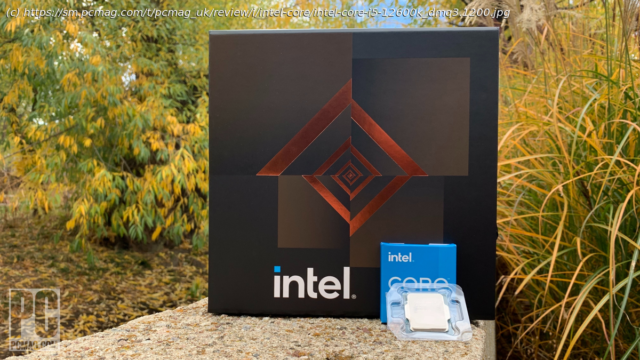Sleeper CPU: Nearly a 10th Gen Core i9, disguised as a 12th Gen Core i5
“Alder Lake,” Intel’s 12th Generation family of CPUs, has three primary members at launch: the two go-go-performance parents (the Core i9-12900K and Core i7-12700K), alongside junior (the Core i5-12600K). Well, that kid is precocious: Intel’s new Core i5-12600K ($289) desktop CPU may bring up the rear of the company’s first set of 12th Gen chips, but it posts some impressive gains over its predecessors in Intel’s line. The Core i5-12600K finds itself sandwiched within a series of near-impeccable midrange CPU launches from AMD over the past year, but there’s no denying the Core i5-12600K’s prowess on display here. It comes within spitting distance of matching the content-creation results of older, former mega-core monsters like the $989 Intel Core i9-10980XE Extreme Edition and the $499 AMD Ryzen 9 3900X. It even manages to beat the 10-core, $449 Core i9-10900K in some of the same tests. That said, its integrated graphics performance is still dwarfed by the similarly threaded, Editors’ Choice-winning Ryzen 7 5700G and six-core Ryzen 5 5600G, which provide a much stronger value proposition to gamers looking to build their next rig around a system-on-a-chip (SoC), without a graphics card. If you want serious content creation power out of a chip class that’s historically been known for midrange gaming, the Core i5-12600K is certainly equipped for the job. Just be ready to pay a pretty penny to get yours off the ground, thanks to the new (and pricey) Z690 motherboard platform taking tickets at the door. The Core i5-12600K: Intel’s 12th Gen Ace in the Hole Based off Intel’s new “7 Process,” the company’s 12th Generation desktop CPUs are built on 10nm lithography and employ a new motherboard socket (LGA 1700), finally breaking the company out of its half-decade love/hate affair with the 14nm process and its iterations that followed for years after. You can read more about how Intel defines its “7 Process” in-depth at ExtremeTech. You’ll notice in the spec chart below some new CPU-core types being thrown around, stuff like “P-cores” and “E-cores.” To find out everything you need to know about those terms and more, check out our full breakdown of Intel’s Performance Hybrid Architecture in our in-depth review of the Intel Core i9-12900K, essential reading for understanding what is new in Alder Lake. We won’t repeat all that detail here. Though the Ryzen 5 5600X, at first, seems like the obvious AMD foil for a direct comparison to the Intel Core i5-12600K, in practice the Core i5-12600KF would be a more fitting opponent, since neither it nor the AMD chip has on-CPU graphics. (Intel is offering “KF” versions of its initial Core i9, i7, and i5 Alder Lake chips, making six total chips at launch.) Instead of focusing on that chip, then, we’ll turn our attention to how the Intel Core i5-12600K stacks up against two of the best moderate-priced Ryzen chips we’ve tested yet—and the ones AMD most recently released in the desktop gaming space—the Ryzen 5 5600G and the Ryzen 7 5700G. These two flank the Core i5-12600K on price, at $239 and $329, respectively. (Those are current street prices; the list prices are $259.99 and $359.99.) And both have integrated AMD Radeon RX Vega integrated graphics that, as we’ll show in more detail below, are often capable of standing in for a discrete graphics card when the moment calls. Intel Core i5-12600K Spec Comparison With that brief intro out of the way, let’s jump into some specs… As a 12th Gen Intel Core processor, the Core i5-12600K is just like the rest of its Alder Lake kin, bearing two different core types on board: in this case, six performance cores (those “P-cores” we mentioned earlier), and four “E-cores,” with the “E” short for efficiency. These add up to a maximum concurrent-processing-thread count of 16, with only the P-cores getting the two-threads-per-core Hyper-Threading support this time around. On cost, the Intel Core i5-12600K doesn’t break any major barriers as far as price creep up the stack is concerned, and it remains slotted right between several members of AMD’s Ryzen 5 and Ryzen 7 chip family, squarely in the midrange. The Intel Core i5-12600K comes with the same integrated graphics as the rest of the “K”-series CPUs in the 12th Gen—the company’s new Iris Xe UHD Graphics 770 silicon—though “new” is a bit disingenuous. The main changes from UHD Graphics 750 are a slightly reduced base clock speed (300MHz, down from 350MHz), and an increased peak dynamic frequency (up to 1.55GHz, from 1GHz). So now that we know what’s under the hood of Intel’s latest midrange offering, how did it do in testing? Let’s jump into the results and see what surprises Intel has in store… Testing the Core i5-12600K: A Generational Leap, With AMD Always Close Behind We tested the Core i5-12600K on an MSI MPG Z690 Carbon WiFi motherboard, with 32GB of DDR5 Corsair Dominator memory clocked to 4,800MHz, and a 4TB Sabrent Rocket Q4 PCI Express 4.0 boot SSD that also functioned as our game drive. All this was packed in Corsair’s iCue 7000D Airflow chassis, fitted with a Corsair iCue H150i Elite Capellix 360mm liquid cooler, and a Corsair 1,000-watt RM1000X power supply. For our gaming tests, we used an Nvidia GeForce RTX 3080 Ti, at Founders Edition clocks, as we have on all recent mainstream and high-end CPU reviews. We test CPUs using a variety of synthetic benchmarks that offer proprietary scores, as well as real-world tests using consumer apps such as 7-Zip, Adobe Photoshop, and Adobe Premiere (the Adobe apps being tested with workloads via workstation maker Puget Systems ‘ PugetBench extensions).






